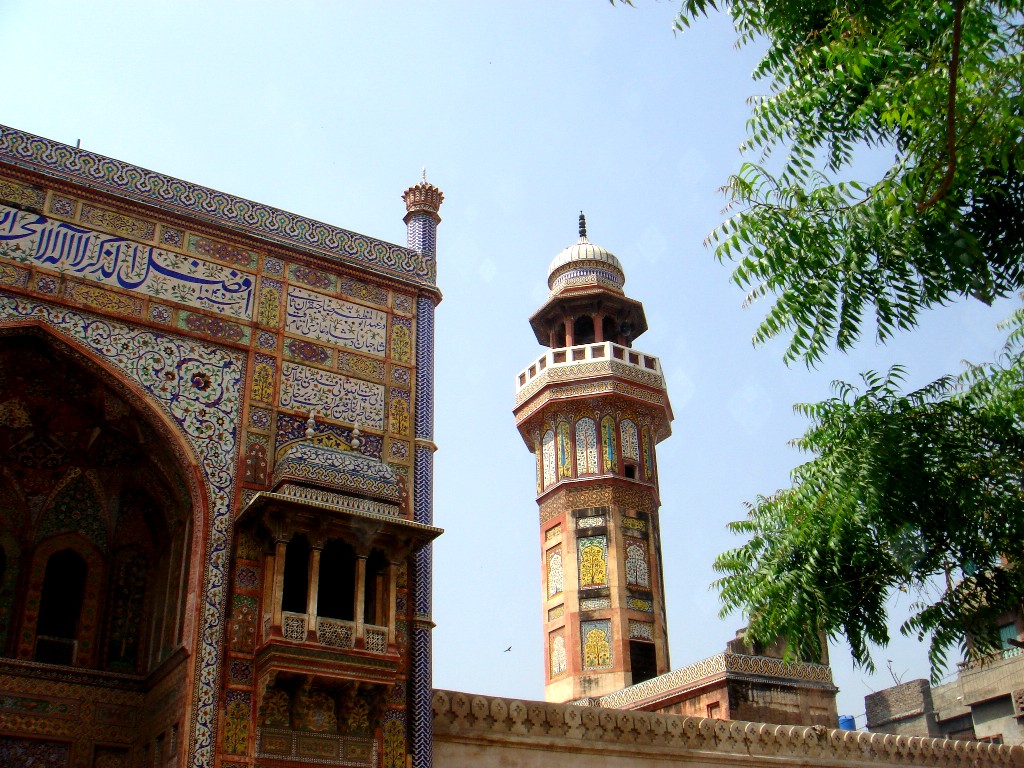- Wazir Khan Mosque
Infobox religious building
building_name=Wazir Khan Mosque
caption=Gateway to the Wazir Khan Mosque.
location=Flagicon|Pakistan Lahore,Pakistan
geo=
religious_affiliation=Islam
rite=
province=Punjab
district=Lahore
consecration_year=
status=Mosque
leadership=
website=
architect=
architecture_type=Mosque
architecture_style=Islamic, Mughal
facade_direction=
year_completed=
construction_cost=
capacity=
length=
width=
width_nave=
height_max=
dome_quantity=
dome_height_outer=
dome_height_inner=
dome_dia_outer=
dome_dia_inner=
minaret_quantity=
minaret_height=
spire_quantity=
spire_height=
materials=The Wazir Khan Mosque in
Lahore ,Pakistan , is famous for its extensive "faience" tile work. It has been described as ' a mole on the cheek of Lahore'. It was built in seven years, starting around 1634-1635 A.D., during the reign of the Mughal Emperor Shah Jehan. It was built by Shaikh Ilm-ud-din Ansari, a native ofChiniot , who rose to be the court physician to Shah Jahan and later, the Governor of Lahore. He was commonly known as Wazir Khan. (The word "wazir" means 'minister' inUrdu language.) The mosque is located inside the Inner City and is easiest accessed fromDelhi Gate .Construction
In his published notes, F H Andrews, former Principal of the Mayo School of Arts, describes the mosque thus: 'The material used in the construction of the Mosque is a small tile-like brick universally used by the Mughals when stone was unusable or too costly. The only stone used in the building is used for brackets and some of the fretwork ("pinjra"). The walls were coated with plaster ("chunam") and faced with a finely-soft quality of the same material tooled to a marble-like surface and coloured. All the external plasterwork was richly coloured a rich Indian red, in true fresco, and the surface afterwards picked out with white lines in the similitude of the small bricks beneath. The extreme severity of the lines of the building is relieved by the division of the surfaces into slightly sunk rectangular panels, alternatively vertical and horizontal, the vertical panels having usually an inner panel with arched head or the more florid cusped "mihrab". These panels, where they are exposed to weather, are generally filled with a peculiar inlaid "faience" pottery called "kashi", the effect of which must have been very fine when the setting of deep red plaster of the walls was intact.'
'The facade of the sanctuary is practically covered with "kashi" and is divided into the usual oblong panels. A beautiful border is carried rectangularly round the centre archway, and inscriptions in Persian characters occur in an outer border, in a long panel over the archway, and in horizontal panels along the upper portions of the lower walls to right and left. The spandrels are filled in with extremely fine designs.'
'With the "minars", however, the facade of the sanctuary, and the entrance gateway, where a small portion of the surface was left for plaster, the effect of the gorgeous colours against the soft blue of a Punjabi sky, and saturated with brilliant sunlight and glowing purple shadow is indescribably rich and jewel-like.'
'Right and left of the sanctuary are two stately octagonal "minars" 100 feet in height. On the long sides of the quadrangle are ranged small "khanas" or cells, each closed by the usual Indian two-leaved door set in a slightly recessed pointed arch, of which there are thirteen on each side by a pavilion rising above the general level, containing larger apartments and an upper story reached by two flights of steps, which also give access to the roof of the arcading and pavilions...these pavilions occur, in the centre of the north and south sides of the lower level of the pavement. In the pavilion on the south side is a fountain set in a circular scalloped basin, and served from the main which supplies the tank in the quadrangle.'
Within the inner courtyard of the mosque lies the subterranean tomb of Syed Muhammad Ishaq, known as Miran Badshah, a divine from Iran who settled in Lahore during the time of the Tughluq dynasty. The tomb, therefore, predates the mosque.
Gallery
See also
*
Badshahi Mosque
*Mosques of Lahore
*Lahore
*Islamic Architecture External links
* [http://www.photoblog.com/pakistan/2007/11/17/wazir-khan-mosque.html Pakistan's Photoblog - Photographs of Wazir Khan Mosque]
* [http://travel.webshots.com/album/553621356coEdrh Photographs of Wazir Khan Mosque]
* [http://www.streetphotos.net/pakistan/wazir.htm Streetphotos.net - Wazir khan] : Images from in and around the Wazir Khan mosque in Lahore, Pakistan
Wikimedia Foundation. 2010.
